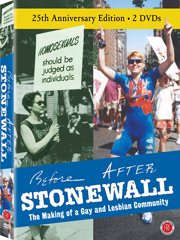Getting There: ‘Before and After Stonewall’ chronicles our journey to equality
On the way to where we’re going, it is important to know where we’ve been.
Before and After Stonewall: The Making of a Gay and Lesbian Community fills in the historical blanks that are too often left empty about the origins of our gay and lesbian heritage. Commemorating the quarter-century since the 1985 release of producer John Scagliotti’s original documentary, this double-disc set features juicy details of what motivated recognizable names like Harvey Milk, Audre Lorde, and Larry Kramer to give voice—a loud, occasionally obnoxious voice—to a movement that at one time dared not speak its name.
But the twin documentaries Before Stonewall and After Stonewall serve an even greater purpose by introducing us to less-recognizable matriarchs and patriarchs—names like former Maine State Representative Ann Noble, the first-ever openly gay person elected to major public office, in 1975. Noble was preceded by drag queen and Imperial Court founder Jose Sarria, who ran, though unsuccessfully, for the San Francisco Board of Supervisors in 1961, 18 years before the lipstick was smeared at Stonewall Inn.
There were other pioneers, like Carroll Davis, Gladys Bentley, Harry Hay, Frank Kameny, Barbara Gittings, Evelyn Hooker, and dozens more for whom “cracking the shield of invisibility” was Job One. Their stories recall a pre-Don’t Ask, Don’t Tell time when gay men hid in plain sight by enlisting in the most macho of fighting units in World War II, andwhen dozens of lesbians outed themselves to Gen. Dwight Eisenhower after he threatened to rid their unit of its lesbian menace, eventually causing the stunned commander to stand down.
Priceless archival film footage and photo stills take us to San Francisco’s Barbary Coast, New Orleans’ French Quarter, and New York City’s Harlem during an era, beginning in the 1920s, when gaydar was not just an unexplainable luxury but an essential tool. Also included are gems like the unimaginably brave 1950s-era lesbian “wedding” and the Mattachine Society’s staid equality protest in Philadelphia in 1965.
Appropriately, After Stonewall picks up where Before left off, tracing the gay community’s new confidence emerging in the 1970s, only to be stamped down again with the introduction of AIDS a mere decade later. If fighting for equality seemed like a matter of life and death for homosexuals prior to Stonewall, the years following would be a horrible, decimating—yet ironically unifying—confirmation of that urgency: “Everything we did had the possibility of changing the world,” recalls author Dorothy Allison.
Prior to Stonewall, being gay was all about choices—four of them, to be specific: prison, commitment to an asylum, suicide, or secrecy. And then, in what appears to the uninitiated as a whoosh of progress, Elton John came out, Massachusetts legalized same-sex marriage, and an open lesbian was elected mayor of Houston. Before and After Stonewall is required viewing for anyone with a vested interest in how—and why—that whoosh happened.
First Run Features (www.firstrunfeatures.com).












Comments